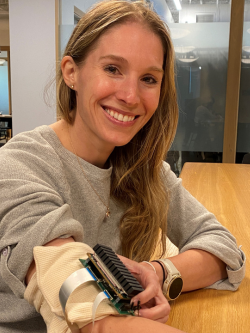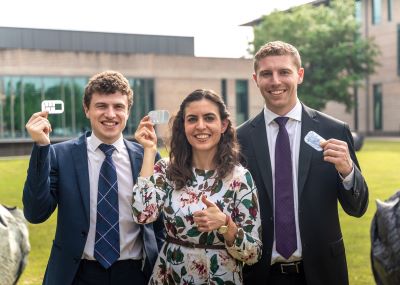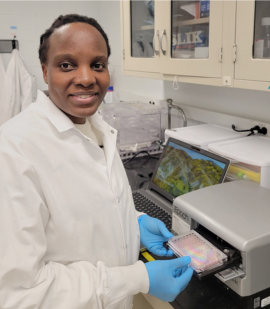Fellows share their perspectives on the unique program
Bringing new medical technologies to the marketplace is a long expensive process that requires a variety of skills and resources. It can be even more challenging for women and other underrepresented entrepreneurs in biotechnology. Women entrepreneurs, in general, often face barriers to funding, are excluded from traditional networking opportunities, and/or have their competencies disregarded or abilities underestimated.1
Recognizing there was a lack of biotechnology innovators from underrepresented groups and building on its history of working with leaders in the biotechnology industry, NIBIB created the RADx® Tech DIVE (short for diversity) fellowship program to increase diversity.
“We created a new fellowship that would give under-represented innovators in the biotechnology community the knowledge and skills they need to move their medical technologies forward toward commercialization,” said Tiffani Lash, Ph.D., NIBIB program director in the Division of Health Informatics Technologies.
Among the first group of DIVE fellows are three women who want to bring their medical technologies to market to improve public health. Their technologies, including diagnostic biomarkers and self-testing platforms, are at different stages of development.

Alaina Rajagopal, M.D., Ph.D., spent decades training to be a scientist and physician, but when she co-founded a start-up to bring a non-invasive continuous blood pressure device to customers, she wanted to learn more about entrepreneurship, especially the financing and regulatory aspects of bringing a product to market.
Eydis Lima, who self-identifies as a Cuban-American woman, has a M.S. in entrepreneurship. As the founder and CEO of a start-up, she wanted to increase her knowledge of fundraising strategies to take her diagnostic patch for cervical cancer and gynecologic malignancies to the next level.
Zoe Sekyonda, a fifth year Ph.D. student in biomedical engineering at Case Western University from Uganda, has built a device that can rapidly measure oxygen levels in blood samples, but needed help with creating and articulating a business model to attract investors.
These women are among the first 14 fellows to complete the program. They were selected based on whether they were from a historically underrepresented group in biotechnology research, had or were pursuing advanced degrees in medical or technical fields, and were the clinical or technical leads on innovative medical technology projects.
Rajagopal said, “I appreciate that RADx Tech DIVE is focused on increasing diversity and providing mentoring and assistance to people who are not traditional entrepreneurs or traditional start-up founders.”
A recent survey2 of 42 U.S. biotech companies found that few people from underrepresented groups lead those organizations. Only 1% of executives, 3% of board members, and 3% of CEOs identified as Black or African American. The same percentages applied to those who identified as Hispanic or Latinx.
Another survey3 of nearly 700 tech and health care founders and executives found that women fare somewhat better in leading biotechnology companies: 41% are C-Suite executives; 37% are board members; and 26% are founders.
Unique features of the program
The fellowship features an online 28-week program that addresses the critical elements of the innovation pathway from uncovering unmet medical needs to commercialization. The program faculty are experienced health technology entrepreneurs who teach topics such as business models, project planning, regulatory processes, intellectual property, reimbursement, funding, pitching, and networking.
The fellows are organized in small groups and matched with a pair of mentors, who are also experienced health technology entrepreneurs.
“Fellows are expected to form business-related hypotheses, and then test their assumptions or theories by interviewing the different interested parties, including patients, clinicians, and hospital managers,” said John Collins, Ph.D., DIVE program director and director of innovation platforms at CIMIT, NIBIB’s partner in the DIVE fellowship. The fellows and mentors meet biweekly in small groups to discuss their hypotheses and findings.
Preparing fellows for fundraising
A major challenge for medtech innovators is raising enough funds to cover the costs of developing their technology and then conducting validation, feasibility, and clinical studies that are required for U.S. Food and Drug Administration (FDA) approval.
The total average cost for medical technology solutions is about $30 million for low-risk products and about $90 million for high-risk products, according to a survey4 of over 200 medical technology companies.

The program prepares fellows for this challenge by teaching them how to: develop and validate a compelling business case; translate that business model into a compelling pitch to potential investors; and address early-stage funding gaps by securing federal funding.
Fellows can also discuss funding challenges they face with their mentors who are experienced in obtaining funding. Having the opportunity to have those discussions was important to Rajagopal and Lima, who lead startups. Rajagopal said, “being able to leverage the expertise of mentors to learn about the regulatory process and financing the company were the two things we focused on a lot during the program.”
Lima said, “Our mentors helped us develop a new process for networking with investors that built momentum when someone was interested in us.”
What was most valuable
Sekyonda said that one of her goals for the fellowship was to learn how to fully conceptualize the idea for her product. The program helped her clarify what exactly she wanted to deliver to customers, for example, whether it was a device or an assay, and the primary reason the customer would want to use her product. She also used the feedback she received to simplify the technology design further.
The fellows also had to define and interview the end-users of their technologies. Rajagopal said her target audience was physicians, nurses, and other health care professionals. “We took the opportunity to interview many of them to understand their pain points and how our device would be helpful or problems they might see in our device as we’re developing it. We wanted to know about any issues now rather than after we fully developed our product,” she said.
Lima said, “What I found most valuable was the mentoring and the availability of instructors who were experts in areas that we needed help with, such as reimbursement.”
Moving their projects forward

Zoe Sekyonda, holding a prototype of her device that can rapidly measure oxygen levels in blood samples.
Credit: Calvin Abonga, Ph.D., at Case Biomanufacturing and Microfabrication Laboratory, Case Western Reserve University
Based on their mentors’ assessment of their progress throughout the program, four fellows received $7,500 each for future endeavors. In addition to Sekyonda and Rajagopal, Asma Mirza and Danielle Nicklas were selected. Mirza is founder of Steradian Technologies and invented a fully portable, photon-based respiratory disease diagnostic. Nicklas, a Ph.D. candidate in pathobiology at Johns Hopkins University and CEO and founder of NovvaCup, helped to develop a redesigned menstrual cup that is easy to use, affordable, and sustainable.
The fellows were also chosen based on who would use the funds most effectively to increase the chances of moving their innovations toward commercialization, said Collins.
Sekyonda plans to use the funds to attend conferences next year and to cover expenses for clinical validation studies of her product.
Rajagopal plans to use the funds to conduct more outreach that will help with her company’s marketing analysis.
“We’re pleased with the progress the fellows made on their point-of-care technologies that can improve public health. This fellowship opportunity is one of several programs created by NIBIB to accelerate the development of tools and technologies to improve human health and support the next generation of innovators and med-tech entrepreneurs,” said Lash.
Small business programs: https://www.nibib.nih.gov/research-program/small-business-programs
Concept to Clinic: Commercializing Innovation (C3i) Program: https://www.nibib.nih.gov/research-program/c3i-program
Online video course: https://www.nibib.nih.gov/entrepreneurial-finance-course
Study References:
1. Balachandra L. et al. (2019) Beyond the bucks: growth strategies of successful women entrepreneurs. a new study by Babson's Center for Women's Entrepreneurial Leadership and Bank of America Private Bank.
2. Howard A. et al. (2021) Bridges to biotechnology and bioentrepreneurship: improving diversity in the biotechnology sector. Nature Biotechnology DOI: 10.1038/s41587-021-01110-3
3. Silicon Valley Bank. (2020) U.S. technology leadership report: key insights from the Silicon Valley Bank startup outlook survey.
4. Makower, J. et al. (2010) FDA impact on U.S. medical technology innovation: a survey of over 200 medical technology companies.
